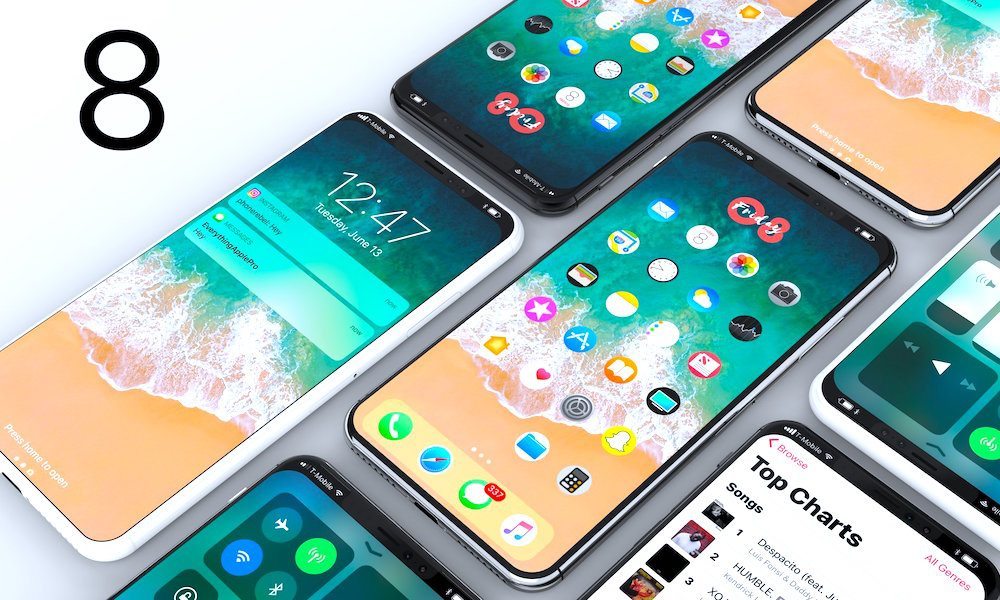iPhone Desperately Needs a Display Boost, Here’s Why It’ll Get It This Year

Image via EverythingApplePro
Toggle Dark Mode
When it was released to high-acclaim in June, 2007, Apple’s iPhone was equipped with one of the largest displays around, which (not by coincidence) boasted one of the highest pixel densities to match. Though paltry in retrospect, the original iPhone’s 3.5-inch half-size video graphics array (HVGA) display, clocking in at 320 x 480 pixels, rendered some of the most immersive graphics of the era in 165 pixels per inch (ppi). It was, for its time, the smartphone display to beat; and it ultimately set the course for what turned out to be a race to pile on the pixels.
History Repeats Itself
During the summers of 2008 and 2009, Apple followed up with the iPhone 3G and 3GS — both of which packed the same, 3.5-inch HVGA display at the same resolution. That all changed in June of 2010, however, when the late Steve Jobs introduced Apple’s first-ever iPhone featuring a Retina display. “It turns out there’s a magic number right around 300 pixels per inch, that when you hold something around to 10 to 12 inches away from your eyes, is the limit of the human retina to differentiate the pixels,” Jobs said while unveiling the iPhone 4, which maintained the 3.5-inch size of its predecessors, while doubling the HVGA resolution to an unconventional, but nevertheless pixel dense, 640 x 960 (or 330 ppi). The iPhone 4s, released in October of that year, featured the same.
Meanwhile, some Android devices of that era (like the Samsung Galaxy Note N7000, released just a month prior to the iPhone 4s), were packing more pixels into even larger displays — although at 5.37-inches, boasting an 800 x 1280 resolution, the Note’s AMOLED display clocked in at just 285 ppi.
In the years that followed, Apple delivered the iPhone 5 and iPhone 5s/5c, in 2012 and 2013 respectively, which stretched the display vertically to 4-inches, while upping the resolution to 640 x 1136 so as to maintain a comparable ~330 ppi. Interestingly, while their display size was later upped substantially to 4.7- and 5.5-inches, the iPhone 6/6 Plus, 6s/6s Plus, and even the most recent iPhone 7/7Plus (released in 2014, 2015, and 2016, respectively) have maintained the same 326 and 401 ppi ever since.
It’s Time for a Change
Within the last few years, the smartphone market has become saturated by high-end Android devices — some of which boast displays as large as Xiaomi’s 6.4-inch Mi MIX, and pixel densities as high as 806 ppi on the 4K-equipped XPERIA Z5 Premium. That’s quite impressive, and while it’s highly unlikely we’ll see an iPhone featuring a 4K display launch anytime soon, we nevertheless have plenty of reason to believe that Apple’s next round of flagships will pile on the pixels. And it’s not merely the fact that it’s been so long since the iPhone’s display has changed, beyond adopting intermittent technologies like True Tone or Wide-Color, that makes us believe this — but rather, a number of recent rumors suggesting that a major shakeup is imminent.
For starters, since as far back as 2015, Apple has been operating a top-secret Display Lab in Taiwan, whereat the company is believed to be working on an all-new Interferometric Modulator Display (IMOD) technology, which will reportedly rival the likes of OLED in terms of both true-to-life color reproduction, power-efficiency, and more. There’s no telling whether this tech will debut on this year’s iPhone lineup, unfortunately, but we know for certain that Apple is exploring ways to reduce its reliance on the rapidly-aging Liquid Crystal Display (LCD).
Samsung Steps in
As for the 5.8-inch OLED-equipped iPhone 8, which is expected to be unveiled in September but released sometime in October or November, we needn’t look much farther than Samsung’s Galaxy S8 to get an idea of what to expect. Featuring a similarly-sized, 5.8-inch AMOLED display, the Galaxy S8 boasts an impressive 1440 x 2960 resolution that equates to a pixel density of 570 ppi. Of course, the reason this is even relevant is that Samsung has been tapped to supply Apple with as many as 160 million OLED display panels this year, which suggests that the iPhone 8’s OLED display won’t be too far behind the Galaxy S8’s, if not better.
And though OLED is currently available only on the Apple Watch, Cupertino is likewise expected to transition its entire range of devices (including all 2018 iPhones, iPads, and possibly even MacBooks and iMacs) from LCD to OLED technology within the coming years. Sadly, the tech-giant has yet to lay out a definitive timeline for a large-scale OLED rollout, however there’s little doubt the days of LCD are numbered, as Apple progresses towards a more power-efficient and vibrantly-lit future.
[The information provided in this article has NOT been confirmed by Apple and may be speculation. Provided details may not be factual. Take all rumors, tech or otherwise, with a grain of salt.]






